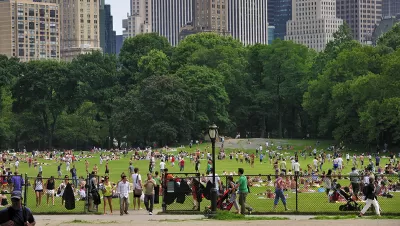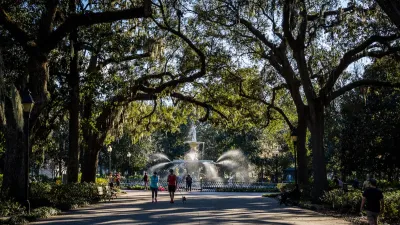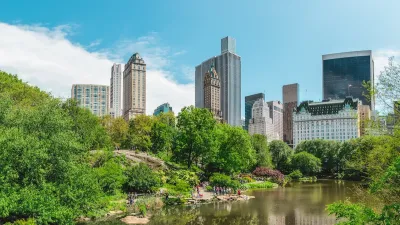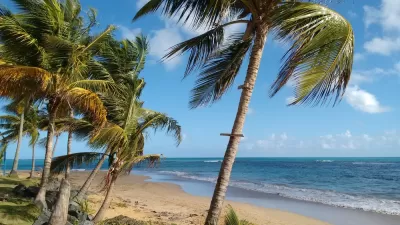A city has always been understood and defined as a pattern of human settlement. This op-ed suggests that a city needs to be a product of its environment, rather than the environment simply being a product of it.

When you think of "city" what comes to mind?
A specific city? One of your favourites?
Tall buildings?
A skyline?
Chaos, people, crowds, traffic?
A river cutting through its centre?
A mountain range backdrop?
A long, long time ago—at least so it feels—I was required to put together a portfolio to gain entrance into an urban design master’s program. It was an assemblage of sketches and pictures and words of what "city" meant to me. Pictures of skyscrapers, a row of shopping carts, barren asphalt parking lots, a crowd of people. I approached a handful or two of acquaintances and coffee-shop attending strangers, explained I was working on a design portfolio and inquired if they would be interested in contributing. For my research I said I'd say one word and that I'd like them to draw what came to mind; I'd give them one minute to draw whatever they wanted. I gave them a pad of paper and a pencil and they smiled or nodded or shrugged.
"Good?" I asked.
"Yes. Hit me."
I said, "City."
And so began my research.
Most drew the iconic building associated with their city of residence—in this case The Calgary Tower. Some drew generic buildings, the ubiquitous tall buildings of cities. A few drew a car on a street in front of a house or those ubiquitous tall buildings. One drew a collection of stick people. I imagine if I asked the question now, I'd see some cyclists.
It wasn't a scientific experiment, but perhaps indicative, illustrative of defining "city." I drew general conclusions, the perhaps rhetorical questions I began this article with: a city is buildings and people—or perhaps more nuanced, people define city based on their experiences of city, the places they create in their mind (and the places that create their mind).
It's probably not earth shattering to say peoples' experiences endow their conceptions of things (a rainy beach vacation can ruin that beach; growing up in an automobile-city normalizes that mode of transportation for you).
Advertising materials of cities tend to reproduce norms: a photograph of its skyline, capturing something unique about the city, perhaps shot from a park or river valley to capture a unique environmental feature. Everything shaped by human habitation, controlling the environment for human habitation, just as "city" might be defined. A textbook on human geography will likely define "city" as a large and permanent human settlement.
I've taken a few lines to get to my argument here—it's been sometime since undergraduate essays and first paragraph thesis statements—but here it is: we need to reframe the definition of "city." I believe the current definition is anemic. As a product of human will, it encourages bending the environment to our will, to whatever development pattern we believe to be right at the given time of development. It induces the ills of urban sprawl and housing market speculation, where cities are little more than tax havens or investment portfolios for foreign money. They are subways, ring roads, concrete plazas, a protected environment.
The growth and management of cities have historically bent nature to conform to it, literally sculpting land and water bodies to suit our building desires; the city has neglected its natural environment, spawning the messes that come with the belief that man (sic) can regulate or control nature—a city built in a flood plain comes to mind, so do magpies and seagulls, urban pests in general.
Living in a city breeds complex human-environment interactions more than any other setting; therefore, generating human health (and property) implications. Writes ecologist Robert McCleery, "Urbanities show measurable physical and psychological benefits associated with time in urban green space, and these benefits increase with greater species richness in the green-spaces."
When we plan and build cities and fail to recognize the potency of nature, its goods, its ills—to seek to balance human and nature—natural ecosystem interactions are lost and the prevailing nature tends to be "urban adapted." Urban wildlife have lost their natural prey/predator interactions and thus become vectors for diseases that pose human health threats. Or nature is the sort that is drug addicted—addicted to herbicides and turf management inputs to manage its "health."
Instead of conservation goals operating in the background of city planning—for example, natural areas being those lands that were not developable for human settlement—planning for conservation must become principled. Investigating the complex human-nature interactions must become one of the foundations of city planning. Not of incidental interest of "sustainability" concepts, of public transit and green roofs and tree lined streets, but proactively understanding and preserving ecological process in human habitations.
A reframing of "city" could elevate conservation practices to the traditional practices of city building for humans, housing configuration planning, transportation network planning, sewage collection, and waste pickup. It would seek the conservation goals we often herald but rarely meet. In a sentence: "city" needs to be reframed from a pattern of human settlement to a spatial configuration, where human needs are integrated with natural ecological processes.
Connect Steven on Twitter @stevenpsnell or Facebook stevenpsnell. Download his novel, Clear Running Water, at Smashwords.

Study: Maui’s Plan to Convert Vacation Rentals to Long-Term Housing Could Cause Nearly $1 Billion Economic Loss
The plan would reduce visitor accommodation by 25,% resulting in 1,900 jobs lost.

North Texas Transit Leaders Tout Benefits of TOD for Growing Region
At a summit focused on transit-oriented development, policymakers discussed how North Texas’ expanded light rail system can serve as a tool for economic growth.

Why Should We Subsidize Public Transportation?
Many public transit agencies face financial stress due to rising costs, declining fare revenue, and declining subsidies. Transit advocates must provide a strong business case for increasing public transit funding.

How to Make US Trains Faster
Changes to boarding platforms and a switch to electric trains could improve U.S. passenger rail service without the added cost of high-speed rail.

Columbia’s Revitalized ‘Loop’ Is a Hub for Local Entrepreneurs
A focus on small businesses is helping a commercial corridor in Columbia, Missouri thrive.

Invasive Insect Threatens Minnesota’s Ash Forests
The Emerald Ash Borer is a rapidly spreading invasive pest threatening Minnesota’s ash trees, and homeowners are encouraged to plant diverse replacement species, avoid moving ash firewood, and monitor for signs of infestation.
Urban Design for Planners 1: Software Tools
This six-course series explores essential urban design concepts using open source software and equips planners with the tools they need to participate fully in the urban design process.
Planning for Universal Design
Learn the tools for implementing Universal Design in planning regulations.
Ascent Environmental
Borough of Carlisle
Institute for Housing and Urban Development Studies (IHS)
City of Grandview
Harvard GSD Executive Education
Toledo-Lucas County Plan Commissions
Salt Lake City
NYU Wagner Graduate School of Public Service






























